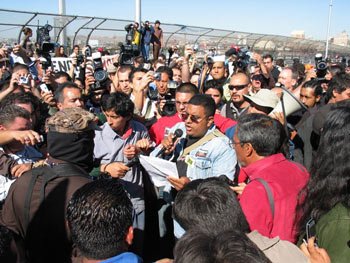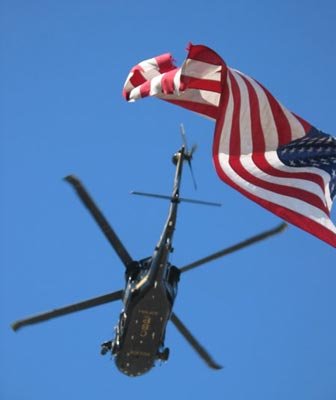


US Customs and Border Protection Helicopter Violated Mexican Airspace, and Agency Rules, During the November 1 Zapatista Protest on the Juárez-El Paso Bridge
Government Source: The Chopper Flew Too Close to Ground, and Too Far into Mexican Territory
By Bill Conroy and Al Giordano
The Other Journalism with the Other Campaign on the Mexico-US Border
November 8, 2006
On the morning of November 1, highways and streets were blockaded from Mexico’s southernmost state of Chiapas to the Texas border in protest of the October 29 Mexican Federal Police invasion of the city of Oaxaca. In some regions, like Chiapas, the blockades took the form of direct action, effectively shutting down transit during business hours on most major routes throughout the state. In others they were symbolic: temporary interruptions of traffic, such as what occurred for 45 minutes on the bridge that connects Stanton Street in El Paso, Texas with Lerdo Street in Ciudad Juárez, Chihuahua. But what distinguished the two focal points on each pole of the Mexican Republic was the difference in response by the law enforcement agencies of each country.
 Photos: D.R. 2006 Chiapas Indymedia |
On the other side of the country, at 10 a.m., Zapatista Subcomandante Marcos – on a national listening tour known as the Other Campaign – stepped out of his vehicle at the end of Lerdo Street in Juárez City, and walked past the vigilance booths onto the bridge that connects Mexico with the United States. Surrounded by reporters, video and other camerapersons – from Commercial and alternative media both – and by hundreds of Other Campaign adherents, he walked up to the summit of the gigantic arced bridge, where he was met by hundreds of adherents from “the Other Side” and began a brief meeting via a megaphone. The crowd (thousands of people and press, the El Paso Times estimated 2,500) occupied the middle of the bridge, along side the cast iron plaque that marks the international border. Police on both sides stopped cars and trucks from entering.
But on the US side, the US Armed Forces, heavily armed with semiautomatic weapons and teargas bazookas, joined the police, who were also accompanied by attack dogs. Another surreal touch had some officers holding “paintball” guns, of the kind kids play with at shopping malls, presumably to be able to “tag” escaping protestors for later arrest? (Shall the day’s wardrobe be turned red, white and blue?)
 |
In his first words through the megaphone, Marcos – a.k.a. Delegate Zero, the handle he uses for this civilian, peaceful, and unarmed mission – made it clear that this would be “a symbolic blockade,” temporary and over as soon as the meeting would end. Yet, suddenly, the din of helicopter blades slapping the air stepped on his words. A chopper labeled “CPB” (“Customs and Border Protection”) of the US Homeland Security agency sped toward the protest from the Texas side. The chopper flew so low that it kicked up an immense brown cloud of dust. A young Mexican girl, accompanying her family on the bridge, began to cry. Someone else shouted “teargas!” With only two exit paths possible, both more than a football field-length away, and down sharp inclines, the protestors and press were sitting ducks, vulnerable to whatever authorities wished to dish out. Not being a normal bridge (one that spans a body of water), there wasn’t even sufficient river to jump into. But the “teargas” turned out to be no more than dust. The meeting continued, although more difficult to hear.
The Customs-Border Protection helicopter then made various circles directly over the meeting – your correspondents estimate that it hovered no more than 150 feet above the heads of the protestors and press – menacing the meeting. Agents filmed the demonstration from above as their targets below shook fists and others flipped them the bird. The young girl took frightened refuge, clinging to the leg of her aunt.
 |
Cooler minds prevailed. When the meeting ended, the assembled from both sides of the border accompanied Marcos and the Other Campaign down into Ciudad Juárez. Delegate Zero boarded his vehicle, as the multitude walked various kilometers to a high school campus for the next meetings of the day (one with adherents from the Other Side, the other, a political-cultural event, with Mexican adherents).
Not content that the demonstrators left the few yards of US territory that the bridge meeting had stepped upon, the Customs-Border Protection helicopter then tailed the march into Mexican territory. Evidently and unquestionably the chopper remained about twenty minutes inside the other nation’s airspace, slowly crawling the sky alongside and above the marchers. Twenty minutes into this spectacle, a helicopter came from the Mexican side, and the US chopper rapidly retreated. What occurred between the two governments at that moment is unknown. However, sources inside US law enforcement filled in some of the blanks for Narco News.
The Doctrine of Overwhelming Force
A source with the US Homeland Security Department (which includes US Customs and Border Protection) told Narco News:
“You are brave to be in the middle of that turmoil. Be mindful of the American reporter [Brad Will] that was recently killed. A discharged bullet or object has no conscience.”
About the “law enforcement techniques” wielded by US officials on that first day of November, the source explained:
“In the academy and in the field we were trained in what is now called the ‘Powell Doctrine of overwhelming force.’“This technique is done for two basic reasons:
1) To deter civil disobedience, and;
2) to have sufficient force to deal with any illegal act and to disperse if necessary.
“Some police forces assign undercover officers into the crowed to apprehend instigators and/or to instigate negative behavior to justify arresting and dispersing demonstrators.
“Helicopters are tremendous intimidators. Officially Fed choppers are not allowed to fly low enough to blow dirt unless it’s a life-threatening event. Feds will be heavily armed, i.e.; 9 mm (SMG) machine guns, but are not authorized to fire from the air under NO circumstances. Officially, they must land and the tactical team will return fire if fired upon.
“This does not apply to local Police Departments. They CAN use snipers to shoot from the air.
“Flying in Mexico air space [is] generally only done with authorization from the Mexican government.”
In sum: The US Homeland Security Department violated its own rules by steering its helicopter low enough to kick up dust in what was, clearly, not “a life-threatening” situation. Its incursion into Mexican territory would only be allowed if specifically authorized by the Mexican government: the chopper’s retreat upon the arrival of a helicopter from the Mexican side suggests the strong possibility that the necessary permission was not obtained.
 |
These and others of the many questions raised by this bizarre and heavy-handed response by the US government to a peaceful protest along the border may soon be asked in another forum and in another context: Tuesday’s change of the political party in control of the US House of Representatives (and, if no 11th hour election fraud is perpetrated, the US Senate, too) already assures – sources on Capitol Hill tell Narco News – that Congressional hearings will soon be conducted regarding the lawless behavior of these law enforcement agencies and others (Customs, Border Patrol, the DEA, the FBI, the Departments of Justice and Homeland Security and the US Attorney in San Antonio, Texas, Johnny Sutton) in the “House of Death” case: in which an informant committed massacres in this same Ciudad Juárez under the protection and with the knowledge of his US law enforcement handlers. The House of Death case is about to pull more threads and uncover more information about how those supposed to enforce the law – on the US side of the border – break it with impunity. It is not far-fetched to imagine that the upcoming Congressional investigations may also dig into the events of November 1, 2006, along the El Paso-Juárez bridge, when those charged with upholding the law broke it once again.
Click here for more Narco News coverage of Mexico
- The Fund for Authentic Journalism
For more Narco News, click here.




